Guinea Pigs
Saturday, September 20, 2014
Small Animal treat and chew DIY
Hey guys! Great tip for spicing up your small animal's day... take your pets favorite veggies and wash them and cut them up. Now take a paper towel and put your prepared veggies in the middle of the paper towel. Now from a ball with the paper towel and veggies and place it in your pets cage. My guinea pigs LOVE trying to figure out how to get to the veggies. It is also safe for them to chew on the paper towel and it helps keep their teeth trim. So give it a try and I hope your animals like it! :)
Friday, April 25, 2014
Guinea Pig Breeds/ Which Is right For You?
Which guinea pig is right for you?
Before you decide to get a guinea pig, you should have in mind a type of breed you would prefer. Also, guinea pigs are very social animals, so I would strongly consider getting at least two. More on that later. Currently, there are 13 known breeds of guinea pigs.
Here is a list of all the different breeds:
Abyssinian/Abyssinian Satin-

Abyssinian guinea pigs have deep, tall rosettes all over the body (in case you did not know, rosettes are whirls of fur that grow evenly from a certain point on the animals coat, making it look tufted and fluffy). You may think these rosettes are random and each guinea pig is unique, but in reality each Abyssinian has eight to ten rosettes. They come in a wide variety of colors.
American/American Satin-

Great breed for those just starting out with guinea pigs! The American breed is a smooth, short haired cavy and requires very little grooming. It is probably the most popular choice of all guinea pig breeds. It has been reported to be the calmest as well. They come in a variety of colors and beautiful shiny coat.
Coronet-

Crested guinea pigs+Silkie guinea pigs= Coronet guinea pigs! The charming Coronet breed has a beautiful crest in addition to a flowing, long coat. While this crest looks very nice, it is important that you check under the hair over the eyes to make sure the guinea pig's eyes are still clear and bright.
Peruvian/Peruvian Satin-

The Peruvian has the longest hair of all the breeds! It is a silky, long haired guinea pig discovered in the late 1800s. All Peruvians have two rosettes on the rump. This lively guinea pigs are known for their bright personality and are the second most (beside American guinea pigs) popular breed. They are not recommended for a first time owner because they do happen to need a lot of grooming to keep their coats knot free. You can tell the guinea pig in the picture has been very groomed. His fur is cut short enough so that he won't accidentally step on it and it is away from his eyes.
Silkie/Silkie Satin (aka Shelties)-

Silkies are very similar to Peruvian guinea pigs, but in some ways they are very different. Their fur grows about 1 inch (2.2 cm.) every month, which is very fast. The Silkie has very short facial hair, a blunt nose and a mane that sweeps along the back with parting. Unlike their cousins, Coronets, they do not have rosettes. Currently, Silkies come in solid, self, marked, broken, white, agouti, tortoiseshell, and Himalayan.
Teddy/Teddy Satin- 
The Teddy has a frizzy, fuzzy coat. It doesn't require a whole lot of grooming. Some guinea pigs that are not the Teddy breed still carry the recessive gene, so they may produce Teddy offspring. This is never a guarantee, however. Sometimes they are incorrectly called a Rex. They are two separate breeds with different DNA. Personality wise, Teddies are very cuddly and have a good nature. They are as sweet and gentle as the look!
Texel-

The Texel marks the third most popular guinea pig breed! It requires a lot of grooming to maintain its coat. You must also have a sort of sense for grooming artistry. The Texel has long, silky ringlets that can be easily damaged by a brush or comb, so it must be groomed by hand. Texels, by and large, are quiet, laid-back animals but are very sweet.
White-Crested-
The beautiful white crest of the American white crested! It is the fifth most popular breed, and it has one white crest on its forehead. This is the only spot where it should have white on its body. The only thing that distinguishes it from the American breed is the crest, and it is what makes them unique! I have only met a few crested guinea pigs in my life, and all have been very shy. Noodles, my own crested guinea pig, is very shy himself. He is, however, incredibly sweet and will stand on his hind legs for treats. White crests love cuddling and don't squeak very much. They very much like hidey houses and hate loud noises.
Other breeds:
Hairless "Skinny pigs" Breed-

The hairless guinea pig, or "skinny pig" have a few short hairs on their body. For the most part they are pretty naked. Make sure your hairless doesn't catch a cold! They may be at higher risk.
More "other" breeds:
English- The English guinea pig has short, straight hair. It is less than 2 inches (3.8 cm). Despite their popularity, English guinea pigs are, inbred or outbred, used in research labs. The good news is the majority are in loving homes.
Merino- This breed is a crested Texel. The hair is longer on the rump than anywhere else.
Alpaca- The Alpaca is also known as the Merino Peruvian. It is a cross between Peruvians and Texels. They have curly fur with a dense coat all over.
Lunkarya- This breed is still being developed, but some breeders are working on perfecting the curly coat. It is a cross of Teddies and Peruvian genetics.
What type of piggie do you have?
Understanding Guinea Pig Noises
Guinea pigs have a large vocabulary and it can really help you, and your guinea pig if you have a better understanding of what your guinea pig is saying. Here are a few descriptions and sound recordings of noises a guinea pig can make. Many people come up with all kinds of different names to describe a guinea pig sound, chut, chubble, wheeeek, rumble are just a few, but I'm sure once you hear the noise and read the description of why piggy is making the noise, you will soon get to recognise what your guinea pig is saying. Remember some sounds can have more than one meaning or sound similar but you can usually tell the differences as their body language plays a large part in how guinea pigs communicate with us or with each other. Please turn your speakers up: With the exception of the last two recordings, you will need to turn your speakers up to hear my piggies. Wheeking Wheeking is aimed at us humans, 'feed me now please'. I have regular times when I feed my piggies fresh veggies, early morning and evening, so they tend to be at their loudest at those times. If its veggie time, I only have to pass their cage and they tell me 'where are you going?, its feeding time mum'. If they hear anything that sounds suspiciously like food might be coming, they will also start a chorus of wheeks. Even closing the back door signals some lovely fresh grass might be on its way or opening the fridge door. Here is a recording of Sweetpea begging for food. 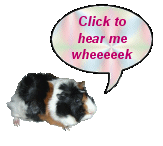 Rumble A rumble, which sounds like a purring sound, happens usually when a male piggy is romancing another guinea pig. A female can also make this sound if she is in season. A rumble sounds deeper than a purr with a vibrating effect. While making this sound a guinea pig will sway their hips and walk around another guinea pig. This is known as the mating dance, other terms used are motorboating or rumble strutting. Here is a recording of Jake in mid rumble, you'll also hear Sweetpea moaning at him :) 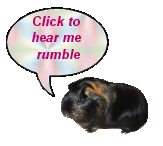 Purring A purring guinea pig is experiencing enjoyment/pleasure. You may hear this sound if you are petting your guinea pig. Purring does sound like a rumble (mating noise). A purr can actually have more than one meaning. If it happens very suddenly, and you aren't petting your piggy, then this purr will sound much shorter and they will suddenly stand still like a statue (freeze). This shorter purr is often described as a 'durr' sound. Its because they have heard a sound like the telephone ringing or a knock on the door and they are afraid of this sudden strange noise. They may just make this noise once or repeat the noise, depending on if the 'threat' has gone away. Some guinea pigs will also make this short sound when they are given a veggie treat. In her excitement my Sweetpea does this nearly every time I offer her vegetables. Hear Squeekie purring while having a cuddle with me. Even stroking him on his head can produce lots of lovely purrs. 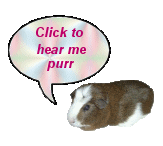 Shrieking Shrieking sounds like a very sharp, high pitched wheek and it means your guinea pig has suffered pain or they may be very afraid. You may hear this sound if a guinea pig has nipped a cage mate or you may hear several shrieks if your vet has given an injection. I remember one visit to the vets, when all my piggies needed mite treatment via injections. Poor Squeekie seemed to always be affected more by an injection as he screamed out so much. I could hear other pet owners in the waiting room going awww. Poor little Squeekie, after a few cuddles from his mum, he was fine. Thankfully, if my piggies ever need mite treatment, they have oral ivomectin, so they'll be having no more mite injections. Guinea pigs can also shriek as a warning to another guinea pig, telling them to 'keep away' if they are showing aggression. As far as I know, a defensive shriek is not made out of aggression, its because the shrieking guinea pig is afraid, panicking and just wants to be left alone and certainly doesn't want to have a confrontation with the other guinea pig. My Peachy normally hates any kind of hostility from another guinea pig, especially from a guinea pig who isn't part of her herd. Peachy normally just runs off to the furthest corner, hoping nobody will notice her. If she's pursued, she will constantly cry out in the hope that the other guinea pig will back off. If its just Jake romancing her, then she will just have a moan at him :) Shrieking can also mean an alarm call. Young guinea pigs calling to their mother or a piggy calling to a cage mate. This can happen if a guinea pigs cage mate is out of the cage or they have been seperated for whatever reason. Here is a recording of my Clover calling for her cage mate Molly who was being weighed at the time. Clover was around 12 weeks old. 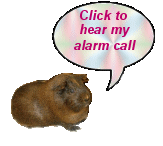 Chut/Chubble/Mutter This is a hard noise to describe, but hopefully by explaining what my guinea pigs do while making this noise, it will hopefully help you identify this sound. When your guinea pigs are out and about, you'll notice they will be happily walking around on the floor, going about their business and this is when they may make a repeated chut sound. It really sounds as though they are muttering to themselves. It means they are relaxed and contented. My Peachy also makes this noise while I'm petting her, accompanied by little purrs in-between, which means she is very happy. As soon as I lift her up and start petting her, she will make this sound, quickly followed by looking at me and giving me a guinea pig kiss :) Here is a recording of Sweetpea happily walking around at free range time. 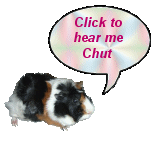 Whining I like to say whining to describe this sound, or you could say moaning/complaining. Its usually heard when a guinea pig is resting and if disturbed by another piggy in the cage, they let their feelings known by moaning at them. It starts off fairly quiet, but will increase in volume if the intruding guinea pig doesn't get the message. My Jasmine likes to complain sometimes. Sweetpea or Jake don't even have to touch her, they could just be tugging at some hay that happens to be close by, Jasmine will then start having a moan. If she's feeling a bit too stroppy she will chin them out of the way or give a little back kick. Its never serious and no fights ever break out, she's just telling them to leave her alone. Peachy and Squeekie also like to moan a bit, especially Squeekie when he wants to be under his mountain of hay by himself. Guinea pigs will also have a moan at us humans if they don't like what we are doing. Clover dislikes being petted anywhere passed her waist. She will also grumble when she's wanting a wee, its just Clover's way of telling me "I need the bathroom mum". Here is a recording of Sweetpea whining at Jake because he wanted some pellets from the food bowl she was using but Sweetpea was determined that he should treat her like a lady and wait his turn as even guinea pigs know its ladies before gentlemen :) 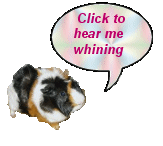 Well as Jake isn't getting the message, Sweetpea becomes very annoyed at Jake as you will hear. Sweetpea's smaller size certainly doesn't stop her from getting what she wants. Sweetpea finally received the result she was hoping for and Jake gave up and ran off to eat some hay, poor Jake :)  Teeth Chattering A guinea pig that starts teeth chattering is an upset/angry guinea pig. If a piggy is heard doing this to another piggy, it means they are agitated and are warning the other guinea pig to keep away. Often guinea pigs that are first introduced to each other will start teeth chattering. When two boars meet for the first time, they may chatter at each other, trying to sort out their position in the hierarchy. It can also happen with sows when they first meet. If teeth chattering increases, the fur around their necks may become raised to make them seem larger. They may also stamp their feet from side to side making themselves rock, looking very stiff with their movements. This isn't the same as a guinea pig rumble strutting, this type of behaviour is aggressive behaviour. If you see your guinea pigs doing this to each other, its best to separate them before they fly at each other, just remember to watch your hands. Place a towel over them to confuse them, then you can separate them. If a guinea pig chatters at you, they are also telling you to keep your distance. Because my Jasmine doesn't like to be picked up, on a rare occasion she will even chatter at me. She's never bitten me though, she just hates being lifted up, once in my arms she's a very happy piggy. So far I've been unable to record one of my guinea pigs chatters as its not something they do very often, so I'd like to say a big thank you to Treen and her guinea pig Fred for allowing me to use a recording of Freds Chatter. 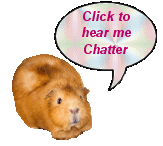 Chirping A rare sound made by some guinea pigs. I have only ever had the good fortune to hear and see my Sweetpea making this sound. I was in another room and suddenly heard what sounded like a bird singing. I even thought a bird may have flown through an open window by accident. When I came to investigate, there was Sweetpea, with her head held high, chirping like a bird. Her little lips were going in and out as though she was whistling a tune. All my other piggies were very still and quiet, as though they were listening to Sweetpea singing. I was so chuffed to witness one of my guinea pigs making this sound, it lasted about 30 seconds. Nothing unusual was happening, so I don't know why she was making this lovely sound. Sweetpea seemed to be in a world of her own at the time. Even when I approched her she continued to chirp for a few more seconds. When she stopped, she went straight to her food bowl, as though nothing had happened. Read this very interesting information about guinea pigs chirping Guinea Lynx: Chirping Although I've heard my Sweetpea chirp on a couple of occasions, I never managed to record her chirping. So I'd like to say a big thank you to Merry and her guinea pig Rosie for allowing me to use a recording of Rosie chirping. Because this recording is a different type of file, you may need the latest version ofQuicktime to hear Rosie chirping. 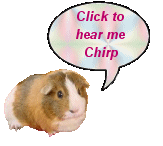  |
Wednesday, April 23, 2014
*DIY Cuddle Cups!*
Cuddle Cup Tutorial
Guinea pigs make wonderful companions.They are known for squeaking with delight when their favorite humans enter the room. They get lonely if they don’t get enough time with their humans.
A great way to handle the piggies is with a cuddle cup. Very soft and large enough for it to lie down and have a nap. They are also washable and quick drying. Our grandkids got guinea pigs for Christmas, Sherlock and Carrots. Here is a pattern for cuddle cups I made for them.
A great way to handle the piggies is with a cuddle cup. Very soft and large enough for it to lie down and have a nap. They are also washable and quick drying. Our grandkids got guinea pigs for Christmas, Sherlock and Carrots. Here is a pattern for cuddle cups I made for them.
Cuddle Cups for Guinea Pigs
Here’s what you will need:
- Fabric for the outside and the inside. I used cotton fabric outside and soft fleece for the inside. I recommend cotton for the outside if you are using straw or shavings for the bedding.
- Batting for the lining. You want the cup to be comfy. I used a high loft batting.
- Terrycloth. This will help absorb any “accidents” while handling the piggies. I used 2 layers of terrycloth.
- Scissors & Pins
- Thread
- Sewing Machine
- An 11″ circle from the outer fabric, inner fabric, and the batting.
- Two 10″ circles from the terrycloth.
- A 30 1/2″ x 5″ strip of the outer fabric, inner fabric and the batting.
 Lay your outer fabric circle face down. Place the batting on top and baste in place with a 1/4″ seam allowance. Next sew the terrycloth circles on top of the batting. Sew a large “X” across the circle to keep it in place.
Lay your outer fabric circle face down. Place the batting on top and baste in place with a 1/4″ seam allowance. Next sew the terrycloth circles on top of the batting. Sew a large “X” across the circle to keep it in place. Match up the short ends of the outer fabric strip, right sides together. Pin and sew. Do the same for the lining fabric.
Match up the short ends of the outer fabric strip, right sides together. Pin and sew. Do the same for the lining fabric. Now Pin the outer fabric strip to the outer fabric circle, right sides together like in picture. Sew together with a 1/2″ seam. Trim.
Now Pin the outer fabric strip to the outer fabric circle, right sides together like in picture. Sew together with a 1/2″ seam. Trim.
Repeat the same for the inner fabric.
 Place the inner and outer sections together, right sides together. Pin and sew a 1/2″ seam. Leave a 3-4″ opening to turn right side out. Be sure the back stitch at the beginning and end of the seam.
Place the inner and outer sections together, right sides together. Pin and sew a 1/2″ seam. Leave a 3-4″ opening to turn right side out. Be sure the back stitch at the beginning and end of the seam.How to Make Your Guinea Pig Happy!
1
Make toys for your guinea pig - you can use cardboard boxes,or even toilet paper rolls!
2
Add a second guinea pig! Guinea pigs are very social animals, so if you are gone for a good majority of the time another guinea pig will keep the other happy!
3
4
Give your guinea pig soft bedding so it doesn't hurt his feet. Guinea pigs do not like to be in pain (They have very delicate feet). If its possible, start using fleece instead of bedding. It's cheaper, prettier, and doesn't smell as long as you wash it once a week.
5
6
Make him special treats. Homemade are best, but make sure it is guinea pig friendly ingredients (no iceberg lettuce!) You can cut up his favorite veggies and thread them together, making a kabob you can hang on the side of his cage.
And give them LOTS of love!!!
Where To Put The Cage?
Where to Put the Cage?
Ideal location: INDOORS
The ideal cage location includes the following elements:
| Draft-free This is the number one criteria! Guinea pigs are very susceptible to upper respiratory infections and drafts are a major culprit. |
| Bright room A nice, bright location with indirect sunlight. If you have a window that you can direct some occasional sunlight on the cage, such as morning light only, that could be good as well. Definitely avoid putting guinea pigs next to bright windows and glass doors. Do NOT put cages in closets or other small enclosed enclosed areas. |
| Stable temperature The room should have a stable temperature range of 65 to 75 degrees F (18 to 24 degrees C). 85 degrees and over and your guinea pig is likely to die from heat stroke. 85 plus degrees is typical in garages in the summertime. If you are comfortable, your guinea pig will be comfortable. If it's too hot or cold for you, it's too hot or cold for them. |
| Low and stable humidity The room which houses your guinea pig should not experience high humidity or fluctuations in humidity. Humidity can be just as bad for your guinea pig as drafts. Avoid areas close to showers where humidity levels soar during and after use. Avoid laundry rooms. Basements finished as part of a home also tend to have higher humidity levels. Be sure of the humidity level before choosing a basement location, and make sure indirect sunlight is also available. | |
| Near family activity This is the last, but not least, requirement. It is critically important to the long-term health and happiness of your guinea pig that you find a place for the cage that is central to family activity or at least just on the immediate periphery. We do not recommend putting cages in children's bedrooms. The guinea pig should be part of family life, even if it is 'designated' as one person's pet. The best location is an area near the kitchen or dining room, with frequent family traffic and visits. When near the source of food, the guinea pigs will help remind you when they want food and attention. Behavior is more easily monitored, interacting with the guinea pigs is easier and therefore more frequent, and the family is more attentive to cage cleaning needs. Living rooms and family rooms can also make good locations. For additional reasons on why cages in children's bedrooms is not recommended, see Cavy Spirit'srelated page on adoption requirements. |
Preferably, Not on the Floor
We generally don't recommend putting cages on the floor for the following reasons:
| Socialization of the guinea pigs You are a walking giant to them when they are on the floor. You are scarier and it is harder for them to be comfortable with you. |
| Activity Footsteps, jumping, running, moving things around, cleaning, vacuuming all create more stress for the cavies when they are on the floor. Vibrations are more easily felt. | |
| Children Children should be supervised when playing with and handling guinea pigs. It is too easy for them to get to the guinea pigs on the floor and too easy for toy and play accidents to happen--pushing, shoving, throwing things, etc. |
| Drafts Drafts are more noticeable on the floor and can predispose guinea pigs to upper respiratory infections if they are disturbing enough. |
| Ease of petting It is not as easy to walk by and give a pet when the pigs are on the floor. | |
| Ease of feeding, cleaning, changing water bottles If these tasks are not extremely easy to do, they can be overlooked sometimes over the years. |
So, if none of these issue apply to you or you can mitigate the concerns, then putting the cage on the floor may work. If you have any of these issues, you should carefully consider the advantages and disadvantages and take precautions with the elements in your home.
NO GARAGES!
Unless your garage is finished off, insulated and part of your home, it is inappropriate for a guinea pig cage. Drafts, temperature fluctuations, temperature extremes, humidity fluctuations, the possibility of toxic fumes from cars, furnaces, or chemicals and not being connected to the family activity are all reasons why garages are a bad idea for guinea pigs.
NO LAUNDRY ROOMS!
Humidity fluctuations and temperature fluctuations are a recipe for sickness and death. Do not keep your guinea pigs in a laundry room.
Indoors vs. Outdoors
 Excerpt from "The Essential Guinea Pig:"
Excerpt from "The Essential Guinea Pig:"
"It's impossible to truly appreciate life with a guinea pig unless you keep him inside your home. Just like a cat or a dog, guinea pigs are companion animals with personalities all their own. If you don't actually live with a guinea pig day in and day out, you'll never get to know him as well as you could. Likewise, the guinea pig won't get to know you.
If your guinea pig is outside most of the time, the two of you will lead separate lives. You will miss out on the chance to have your pet sleep on your lap while you watch TV and gaze up at you from the floor while you eat dinner. People who live with indoor guinea pigs enjoy these antics and more from their pets.
There are also many other practical reasons for keeping a guinea pig indoors.Guinea pigs who live inside tend to live longer than outdoor guinea pigs.Bad weather and predators are responsible for the demise of many outdoor guinea pigs. These are consequences of outdoor living that even conscientious owners cannot always control.
Illness is a major cause of death among outdoor guinea pigs, mostly because outdoor pets are more difficult to monitor. Signs of sickness can be subtle at first, and because outdoor guinea pigs spend less time with their owners, it can be a day or so before the owner recognizes the illness. In the case of rapidly progressive illnesses, a delay of even one day can cost a guinea pig his life.
The decision to keep your guinea pig indoors is a wise one. Even guinea pigs who have been living outside for years can acclimate to a life indoors."
Tuesday, April 22, 2014
Healthy Cavy Treats!
I have been noticing that pet store now are selling unhealthy piggie treats like.. yogurt, chocolate, bananas, and seeds and nuts.... hello!... those are extremely dangerous to feed guinea pigs! But I have found one really good and healthy treat for my piggie. They are called Oxbow Organic Barley Biscuits. They have pretty good ingredients( not perfect but close) and he LOVES them. Drop by and pick of a bad at Petsmart! Your Piggies will love them. And they are only $5!!
Subscribe to:
Comments (Atom)






